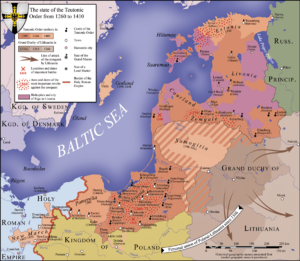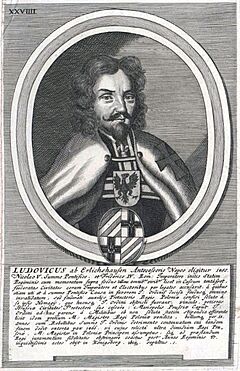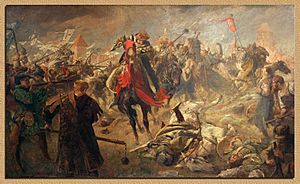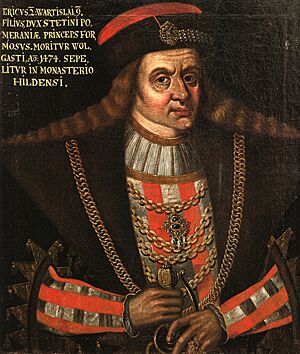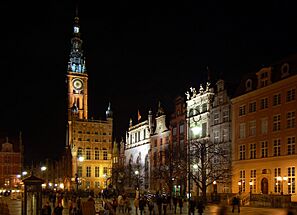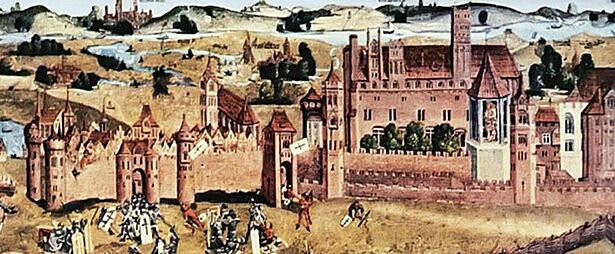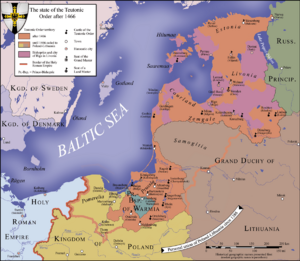Thirteen Years' War (1454–1466) facts for kids
This is the 1454-1466 Polish-Teutonic War. For a list of all Polish-German Wars, see Polish-German Wars.
Quick facts for kids Thirteen Years’ War |
|||||||||
|---|---|---|---|---|---|---|---|---|---|
| Part of the Polish–Teutonic Wars | |||||||||
 The Polish melee infantry (right), crossbowmen (left) and some foot/dismounted knights (middle). |
|||||||||
|
|||||||||
| Belligerents | |||||||||
| Commanders and leaders | |||||||||
Supported by:
|
|
||||||||
The Thirteen Years' War was a big fight between the Kingdom of Poland and the Teutonic Order. It lasted from 1454 to 1466. People also called it the War of the Cities.
This war happened because of long-standing problems. The Teutonic Order, a group of warrior monks, ruled a region called Prussia. Many local nobles and townsfolk in Prussia were unhappy with their rule. They felt the Order was unfair with taxes and didn't let them have enough say in how things were run.
These unhappy people formed a group called the Prussian Confederation. They asked the Polish King, Casimir IV Jagiellon, for help and protection. This made the Teutonic Order very angry, and war broke out.
The war ended with Poland winning. A peace treaty, the Second Peace of Toruń, was signed. The Teutonic Order had to become a vassal (a ruler who owes loyalty to a more powerful king) of the Polish King. They also gave back some land to Poland, including Eastern Pomerania and the area of Warmia. These lands became known as Royal Prussia, directly ruled by the Polish King.
Contents
Why the War Started
For a long time, Poland and the Teutonic Order argued over who controlled Eastern Pomerania. The Teutonic Order had taken this land in 1308. This led to many smaller wars between them over the years.
Problems in Prussia
In the 1400s, towns in Prussia were growing fast. But the people there didn't get more power in how their country was run. The Teutonic Knights' rules felt old-fashioned. They charged high taxes and fees for trading grain. This made it hard for businesses to grow.
The nobles in Prussia also wanted more say in their government. They looked at neighboring Poland, where Polish nobles had many rights. The Knights were also accused of breaking promises to the nobles and cities. Even craftsmen were unhappy because of unfair competition.
Over time, different groups in Prussia, like Kashubians, Poles, Germans, and Prussians, started to feel more united. They all wanted similar things. They began to look more and more towards Poland for support.
Back in 1397, some Prussian knights formed a secret group called the Lizard Union. It was against the Teutonic Knights, but it didn't get enough support from the towns. After a big Polish-Lithuanian victory against the Knights in 1410 at the Battle of Grunwald, the Prussian nobles briefly supported the Polish King. But they went back to the Order's rule when Poland couldn't capture Malbork Castle.
On February 21, 1440, a new group was formed: the Prussian Confederation. It included people from Prussian cities, nobles, and church leaders. The Grand Master, the leader of the Teutonic Order, at first seemed to approve of this group. But later Grand Masters were strongly against it.
Asking Poland for Help
In 1452, the Prussian Confederation asked the Holy Roman Emperor, Frederick III, to help settle their fight with the Teutonic Order. But the Emperor sided with the Order. He told the Confederation to obey the Knights in December 1453.
So, the Prussians turned to Poland. They had already been talking with the Poles. They got support from parts of Poland, especially from the Queen's side. However, a powerful bishop named Zbigniew Oleśnicki tried to stop Poland from getting involved in a war.

In January 1454, the Prussian group formally asked King Casimir IV of Poland for protection. On February 4, 1454, the Prussian Confederation officially declared that they would no longer obey the Grand Master. Two days later, they started a rebellion. Soon, almost all of Prussia was free from the Teutonic Order's rule. Many captured castles were quickly destroyed.
On February 10, 1454, the Confederation sent a group to Poland. They asked King Casimir to add Prussia to the Polish kingdom. After discussing the terms, the King agreed. The Prussian delegates then promised their loyalty to Casimir on March 6, 1454.
Poland then sent a declaration of war to the Grand Master. Both sides thought the war would end quickly.
Who Fought in the War
The main fighters were the Kingdom of Poland and the Prussian Confederation on one side. On the other side were the Teutonic Order and their allies, including Denmark and the Livonian Order.
Polish and Prussian Armies
The Polish army mostly consisted of nobles who had to fight when the king called them. They brought their own soldiers and supplies. Cities also provided wagons, food, and support. The army was divided into units based on families or regions. Peasants also joined as foot soldiers. The king was the top commander.
Poland also hired many mercenaries, especially from Bohemia (modern-day Czech Republic). These were professional soldiers who fought for pay. A key tactic they used was the tabor, which involved using wagons to form a moving fort.
The Poles had some early cannons called bombards. Handguns were used but were not very effective. Crossbows were more important and could cause a lot of damage.
The Prussian Confederation's army had local soldiers and small units from cities. They could gather about 16,000 soldiers, plus armed peasants. They also had more artillery than the Polish army. Prussian cities also had a small navy, made of armed trade ships and hired privateers.
Teutonic Knights and Allies
In 1454, the Teutonic Order lost most of its weapons and supplies. But they later built up their army again. They had loyal knights and peasants. However, most of their forces were hired mercenaries, mainly from Germany and Bohemia.
The international situation was generally good for Poland. The Grand Duchy of Lithuania, though ruled by the same king, did not send much help. Other countries like France and England were busy with their own wars. The Pope was focused on fighting the Ottoman Turks. So, not many outside countries got involved in the Thirteen Years' War.
Key Moments of the War
The war lasted 13 years, with many battles and changes in who was winning.
Early Battles (1454)
The first attacks happened from February to August 1454. Prussian soldiers, helped by Czech mercenaries, tried to capture the city and castle of Marienburg. This was the main base of the Grand Master, Ludwig von Erlichshausen. But they didn't succeed.
The Teutonic Order got help from German areas. These new soldiers captured an important city called Konitz. Polish and Prussian forces then tried to besiege Konitz. But the Polish commander was not very skilled, and the Prussians couldn't pay their mercenaries. So, the siege wasn't very effective.
King Casimir IV arrived and received loyalty from the new Prussian subjects. He sent Polish nobles to help at Konitz. But noble cavalry wasn't good at taking castles. The King also sent forces to besiege Marienburg, but they couldn't take it either.
In September 1454, a large army of mercenaries joined the Teutonic Knights. They were led by Rudolf of Żagań and a skilled soldier named Bernhard von Zinnenberg. This army had 9,000 cavalry and 6,000 foot soldiers.
Rudolf's army moved to help Konitz. King Casimir had to call more Polish nobles to fight. On September 18, 1454, the Teutonic Knights defeated the Polish army at the Battle of Konitz. This was a big loss for Poland.
After this defeat, the Polish army left Marienburg. The Teutonic Order took back several towns. This was a great victory for the Knights. But they didn't have enough money to pay their mercenaries. The mercenaries were promised that if they weren't paid by February 1455, they could take over cities and castles.
To fix the situation, King Casimir hired more mercenaries. He also called for another large group of Polish nobles to join the army. This new army had about 3,000 cavalry and 3,000 mercenaries. The Grand Master avoided a direct battle this time. The Polish army tried to besiege a city called Lessen, but they failed to capture it.
Changing Fortunes (1455-1460)
Early talks between the two sides in January 1455 failed. King Casimir had to borrow money to pay his soldiers. He even gave two cities to Eric II of Pomerania to secure northern Pomerania.
The Teutonic Knights managed to take back some eastern parts of Prussia. They were helped by local rebellions caused by high war taxes. The last town loyal to Poland in East Prussia, Kneiphof, was captured by the Knights in June 1455. Poland kept losing ground, even losing the area of Warmia.
However, the Grand Master still couldn't pay his mercenaries. So, the mercenaries took control of Marienburg, Dirschau, and Eylau in May 1455. These mercenaries then started talking with Poland about selling the castles.
The international situation became more difficult for Poland. The Holy Roman Emperor banned the Prussian Confederation. The Pope also threatened to punish them if they didn't make peace with the Order. In June 1455, Christian I of Denmark declared war on Poland. But Denmark was busy fighting Sweden, so this didn't cause too much trouble for Poland.

King Casimir, in debt, called for another army of nobles. This army moved slowly. There were talks to end the war, but the Teutonic Knights refused to compromise after their recent wins. The war continued.
The new Polish army was larger. It included soldiers from different regions and some Lithuanian Tatars. They tried to besiege Lessen again but failed. The Teutonic Knights also took back another city, Memel.
At sea, King Casimir asked Danzig to build a fleet. In May 1456, ships hired by Danzig captured Dutch ships, causing problems with Amsterdam. In August 1457, three Danzig ships defeated a larger Danish-Livonian fleet near Bornholm.
After long talks, the Teutonic mercenaries agreed to sell three castles, including Marienburg, to Poland. On June 6, 1457, Marienburg, Dirschau, and Eylau were given to the Polish army. Two days later, King Casimir entered Marienburg castle. Everyone thought the war would end quickly now that the Teutonic Order's capital had fallen.
But the Teutonic Knights launched a new attack. They got help from Königsberg citizens and free Prussian knights. On September 28, 1457, Teutonic forces took Marienburg by surprise. Only the castle remained in Polish hands. The Knights also recaptured other cities. Poland was saved by a new army from Greater Poland.
In 1458, King Casimir called for another army. This army, led by Piotr of Szamotuly, marched to Marienburg in August. They had good artillery from Danzig and Elbing. But the siege failed again, partly because of long talks and the commander's lack of action. Nobles started leaving the army.
In some areas, peasants rebelled against Polish rule. They captured castles and gave them to the Teutonic Knights.
Talks continued, with Poland suggesting the Teutonic Order move to a different region. A ceasefire was even signed, and peace seemed close. But the Prussian leaders convinced the king to stop the talks.
A positive step was peace with Denmark. King Christian I of Denmark signed a ceasefire with Poland in July 1458, which was later extended.
In 1459, the new Pope, Pope Pius II, tried to get countries to fight the Ottoman Turks. He sided with the Teutonic Order against Poland. He even banned Poland and its king from the church. This made King Casimir very angry.
On March 21, 1460, the Polish army, helped by Danzigers and peasants, began to besiege the town of Marienburg. The castle was already under Polish control. The town finally surrendered on July 5. The mayor of Marienburg was executed for treason because he had sworn loyalty to Poland but then let the Teutonic Knights back in.
This Polish success was quickly met by the Teutonic Knights. They took back other cities in western Prussia. They defeated the Danzig army and burned parts of Danzig. The Teutonic Order also captured several other towns. The situation for Poland became very difficult.
King Casimir again called for nobles to join the army, but many refused. The Polish army was disorganized and returned home quickly. This failure convinced Casimir that he needed a professional army. Nobles agreed to pay new taxes to hire and keep a regular army. The new commander was Piotr Dunin, a skilled leader.
The Final Push (1461-1466)
In 1461, Poland had a big success by capturing the castle of Schwetz. Polish privateers hired by Danzig also did well at sea. The first group of Polish regular soldiers, about 2,000 men, arrived in Prussia in October 1461, led by Dunin. He quickly captured the castles of Lessen and Stuhm.
The Teutonic Knights also captured some cities. The Polish parliament decided to raise new taxes to make the regular army even bigger. In the summer of 1462, Dunin captured the castle of Frauenburg.
King Casimir had problems in Lithuania, which stopped him from fully using Poland's successes. The Lithuanians didn't want the Teutonic Order to move to their territory. This forced the king to start new talks with the Teutonic Order.
On July 3, 1462, talks began in Thorn. Polish and Prussian representatives argued that Pomerania had always belonged to Poland. They pointed to Slavic names, the language, and old church ties. They also stressed that Prussians had freely asked to join Poland. The Teutonic Knights disagreed with all these points. The talks failed.
The Battle of Świecino changed the war. The skilled Teutonic commander, Fritz Raweneck, was killed. After this battle, the Poles, helped by Ulrich Czerwonka, started to win more often. On July 27, 1463, Dunin began to besiege Mewe.
The Teutonic Order sent help to Mewe. But on September 15, 1463, 44 Teutonic ships were destroyed by 30 ships from Danzig and Elbing in the Battle of Zatoka Świeża. Soon after, a Teutonic commander made a separate peace with Poland. Mewe surrendered on January 1, 1464.
The Teutonic Knights faced serious money problems. They got less and less money from the Holy Roman Empire. Their mercenaries, who were the core of their army, weren't paid. This meant they couldn't launch any big attacks. Meanwhile, the Polish and Prussian armies kept winning.
Dunin continued to capture more castles. Local people, angry at Teutonic raids, captured the castle of Soldau. But the king had to leave Poland for Lithuania again, and money problems stopped further advances. More talks in 1465 failed.
In 1466, the Prince-Bishop of Warmia decided to join the Polish forces. Polish forces under Dunin finally captured Konitz on September 28, 1466.
How the War Ended
The many Polish victories made the exhausted Teutonic Order seek new talks. The new mediator was Pope Paul II. With help from the Pope's representative, the Second Peace of Thorn was signed on October 10, 1466.
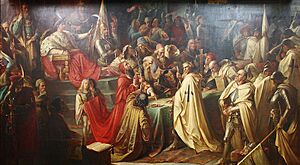
Western Prussia became an independent Polish province, later called Royal Prussia. The area of Warmia also came under Polish rule. Eastern Prussia remained under the Teutonic Knights, but they became a vassal of the Polish king. This meant they had to swear loyalty to the Polish king. The Grand Master also became a Senator in the Polish kingdom.
The treaty was signed by the Pope's representative. Both sides agreed that even though the Pope's approval wasn't strictly needed, they would ask him to confirm the treaty to make sure it was strong. Later, Pope Paul II and Emperor Frederick III questioned the treaty.


